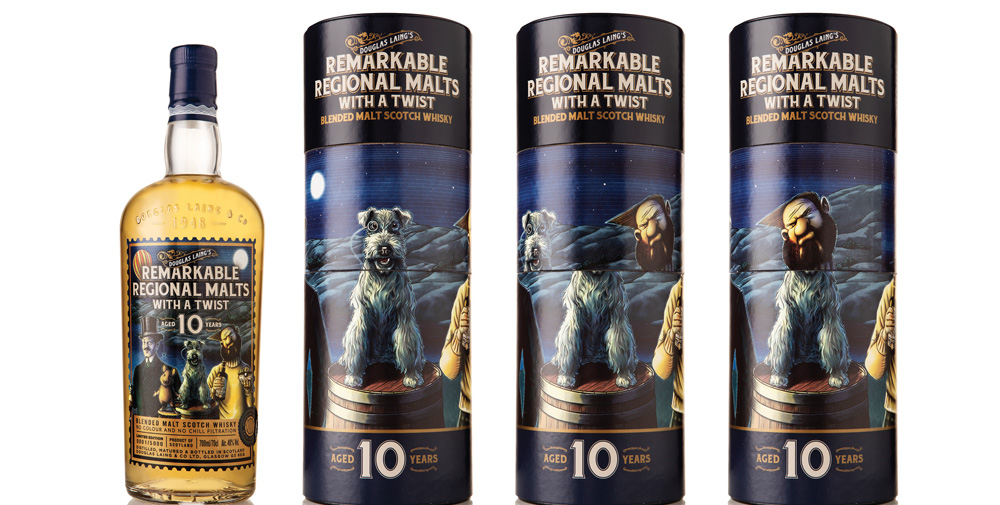
Douglas Laing & Co: 70 Years of Scotch Excellence and Global Growth
Streams of whisky
Douglas Laing & Co celebrated its 70th anniversary in high spirits in 2018, as the artisan producer of Scotch whisky continued to expand both domestically and internationally
It will be relatively safe to conjecture that Douglas Laing & Co – an artisan Scotch producer headquartered in Glasgow – could not have wished for a more cherished gift for its 70th anniversary in 2018. The company’s hard work and dexterous navigation of the Scotch industry over the last seven decades allowed it to smash its own record for bottles of high-quality whisky shipped around the globe last year. Coupled with that, Douglas Laing also had its fifth straight year of double-digit growth – a singular feat that highlights the business’ ever-rising status in the market.
Intelligibly, the number 70 was a recurring theme in Douglas Laing’s newest product ranges released in 2018 to celebrate the company’s anniversary. To tell us more about the princely treats for the palate that were recently added to Douglas Laing’s portfolio, we interviewed the producer’s CEO Chris Leggat.
“We launched a single malt and single grain double pack under the Old Particular brand, which contained a 35-year-old Caol Ila and a 35-year-old Old Cambus, thus combining 70 years of whisky excellence. From the Remarkable Regional Malt series, we also released a 26-year-old Big Peat Platinum Edition, as well as a limited edition of a ten-year-old Scallywag, with the latter equalling 70 years in dog years,” Chris remarks humorously. Surely, Cooper – the Head of the Fox Terriers department at the company – has given the product his seal of approval.
Among the other special items unveiled by Douglas Laing were the four exceptional Single Casks under the XOP Platinum brand and the ten-year-old all-region blended malt called With a Twist, part of its Remarkable Regional Malts brand.
“In fact, the Remarkable Regional Malts brand is the driving force in our business at the moment and the area where we are seeing the highest growth. Within the brand, it is the Big Peat range that is the best performing, representing in a bottle what the island of Islay is all about,” Chris states.
Douglas Laing’s remarkable success in international trade on which we reported at the very beginning of this article has been attributed to the company’s intensified activity in markets considered to be holding an untapped potential, including Asia and the US. Chris discusses the highlights in export for the business: “We opened an office in Taiwan in the summer of 2018 and we are really happy with how business is picking up in Asia at the moment. There are so many opportunities for us to grow in this region and we have a hugely passionate Regional Sales Manager in place to execute the ambitious plans we have to expand our presence on the continent in 2019 and beyond.
“I expect our team in Asia to start growing organically. They are now focused on establishing our brands locally with the nominated country importer. There are a few key markets we have directed our attention to within the continent and we will continue to work hard in those to deliver against our business objectives,” he adds.
The repeal of the Prohibition in 1933 gave rise to the three-tier system of alcohol distribution in the US – a legally justified arrangement that is still in place today, aiming to control the alcohol industry. The three tiers include importers or producers, distributors, and retailers, and in the basic structure of the system, producers can sell their products only to wholesale distributors who then sell to retailers, and only retailers may sell to consumers.
“Such an organisation has inevitably posed significant challenges to the whole industry, but once you start to break down some of the barriers and work with great people in wonderful premises, it becomes a lot easier,” claims Chris. “The US market has grown considerably for us and, like Asia, we are projecting a very successful 2019 for our business in America.
“This year, we also predict the further opening up of the African market and we have identified South Africa as a particularly attractive destination where we can start selling our brands. With consumer confidence rising all the time, it looks like the ideal time to develop all the new markets I have been talking about,” he enthuses.
At present, Douglas Laing is constructing a new £11 million site on the banks of the River Clyde and Chris does not attempt to conceal his excitement for the relocation scheduled to be completed during the year. “It will be a truly world-class facility that will bring all of our offices, the bottling hall, the warehouse, and the distillery under one roof, thus allowing us to maximise control and quality.”
By moving to the new site, Douglas Laing seems to be getting ready to climb to the next level of the company’s development ladder, and Chris insists that the scope for growth is enormous. “We are certainly pushing for another year of strong double-digit volume increase. In order to meet our targets, we have to continue serving our global customer base in the correct manner – by offering the finest quality of Scotch whiskies and delivering innovative customer service.
“The beauty of being a family business is that we are able to outline our path for the short-, medium-, and long-term, and when thinking about the next five years, we are confident that the outlook is great. Perhaps, we may even see a second distillery appear,” Chris concludes by providing us with a little teaser of the next major milestone Douglas Laing will be pursuing in the years to come.